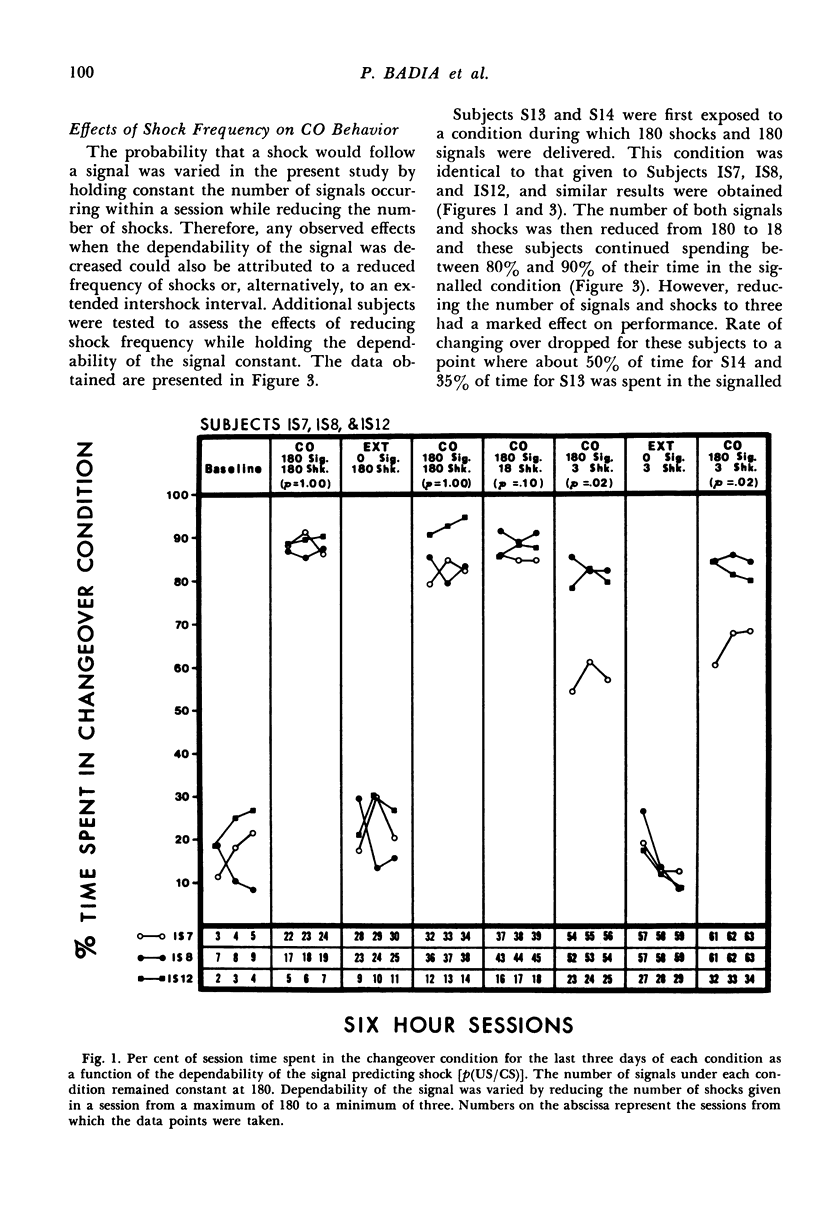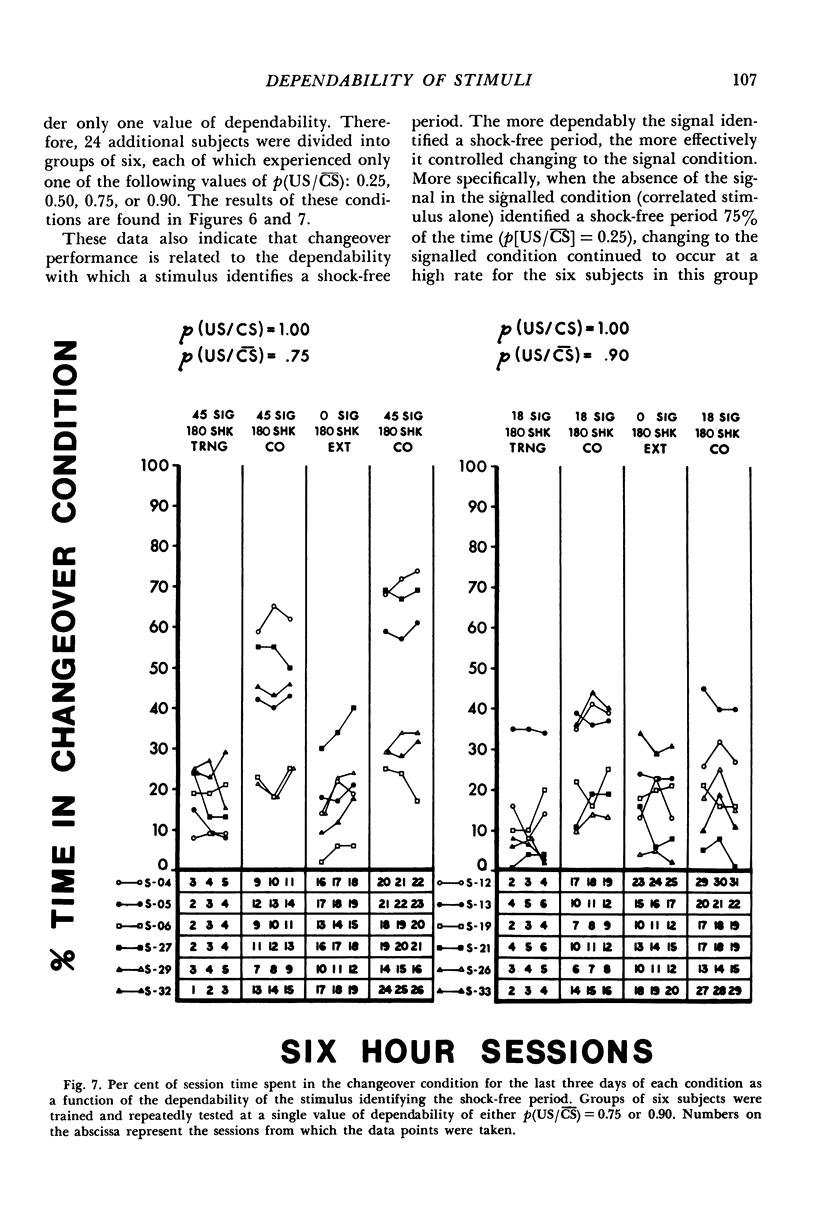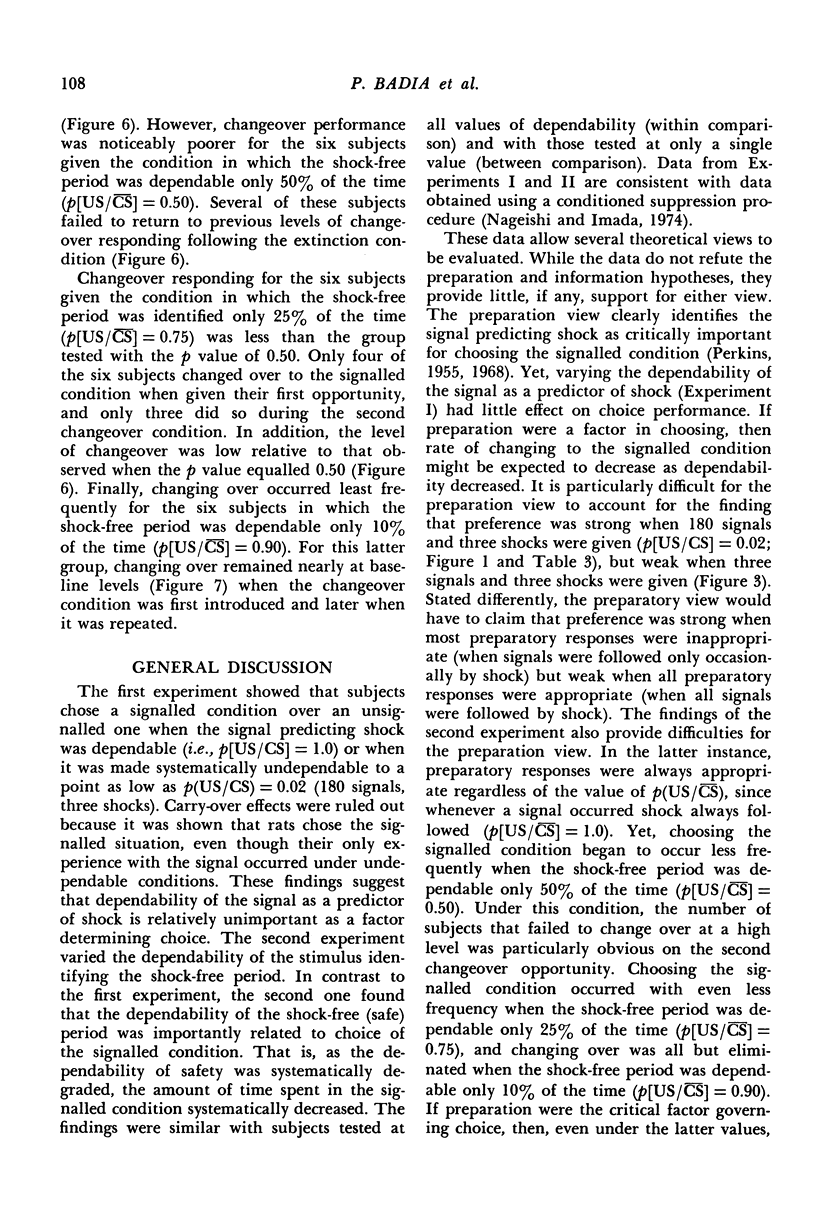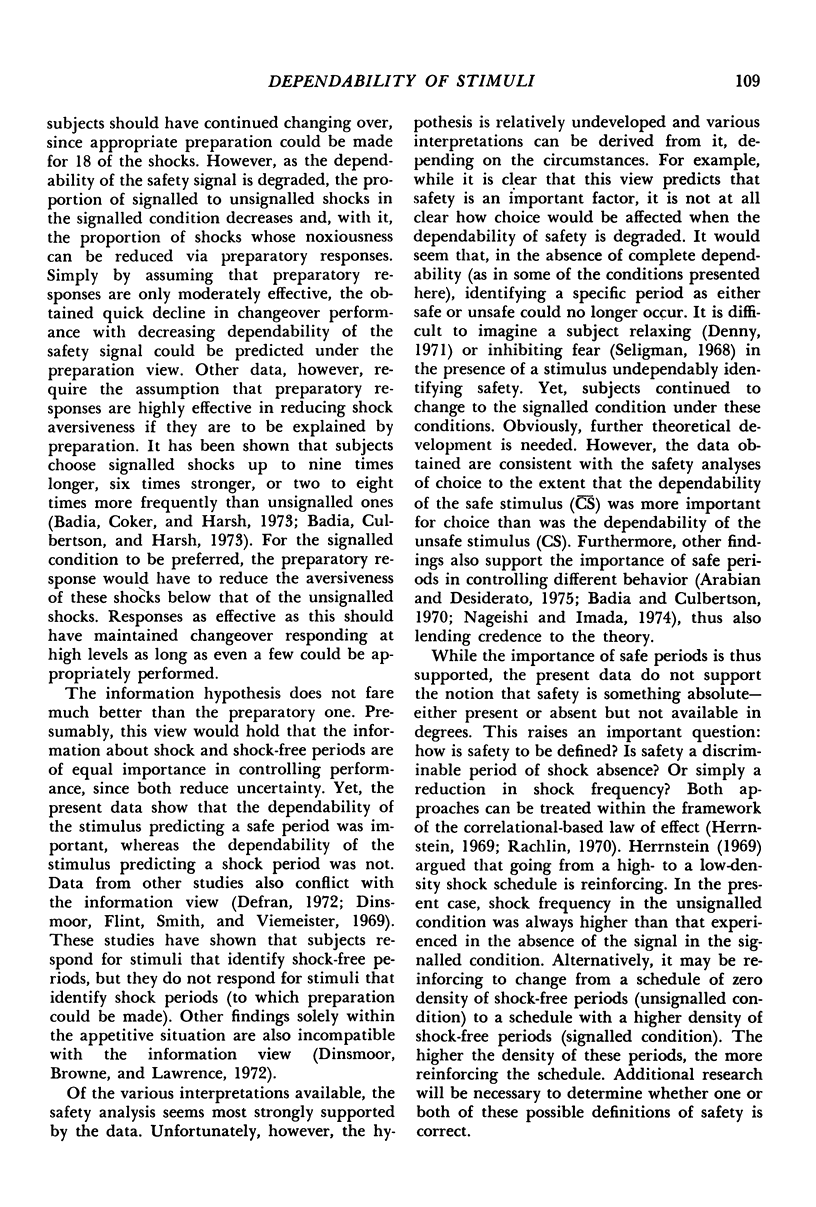Abstract
This study assessed whether choosing a signalled shock condition over an unsignalled one is controlled by a stimulus that predicts the presence of shock (Experiment I), or by a stimulus that predicts the absence of shock (Experiment II). The dependability of these stimuli as predictors of either the presence or the absence of shock was parametrically varied over a wide range, and subjects (rats) were given an option to change from an unsignalled to a signalled condition. In the first experiment, all shocks were preceded by signals; however, the probability of a signal being followed by shock varied from 1.0 to 0.02. The data obtained indicate that the dependability of the signal as a predictor of shock is unimportant. Rats changed to the signalled condition when the signal was completely dependable (all signals followed by shock) and when the dependability of the signal was systematically degraded. In the second experiment, all signals were followed by shock; however, some shocks were not preceded by a signal. The data show that the dependability of a stimulus predicting the absence of shock is important in that, as dependability decreases, changing to the signalled condition also decreases.
Keywords: choice, dependability, predictability, signalled shock, changeover, rat
Full text
PDF
















Selected References
These references are in PubMed. This may not be the complete list of references from this article.
- BRIMER C. J., KAMIN L. J. Disinhibition, habituation, sensitization, and the conditioned emotional response. J Comp Physiol Psychol. 1963 Jun;56:508–516. doi: 10.1037/h0039925. [DOI] [PubMed] [Google Scholar]
- Badia P., Coker C., Harsh J. Choice of higher density signalled shock over lower density unsignalled shock. J Exp Anal Behav. 1973 Jul;20(1):47–55. doi: 10.1901/jeab.1973.20-47. [DOI] [PMC free article] [PubMed] [Google Scholar]
- Badia P., Culbertson S. A., Harsh J. Relative aversiveness of signaled vs. unsignaled avoidable and escapable shock situations in humans. J Comp Physiol Psychol. 1974 Aug;87(2):338–346. doi: 10.1037/h0036851. [DOI] [PubMed] [Google Scholar]
- Badia P., Culbertson S., Harsh J. Choice of longer or stronger signalled shock over shorter or weaker unsignalled shock. J Exp Anal Behav. 1973 Jan;19(1):25–32. doi: 10.1901/jeab.1973.19-25. [DOI] [PMC free article] [PubMed] [Google Scholar]
- Badia P., Culbertson S., Lewis P. The relative aversiveness of signalled vs unsignalled avoidance. J Exp Anal Behav. 1971 Jul;16(1):113–121. doi: 10.1901/jeab.1971.16-113. [DOI] [PMC free article] [PubMed] [Google Scholar]
- Badia P., Culbertson S. The relative aversiveness of signalled vs unsignalled escapable and inescapable shock. J Exp Anal Behav. 1972 May;17(3):463–471. doi: 10.1901/jeab.1972.17-463. [DOI] [PMC free article] [PubMed] [Google Scholar]
- Davis H., McIntire R. W. Conditioned suppression under positive, negative, and no contingency between conditioned and unconditioned stimuli. J Exp Anal Behav. 1969 Jul;12(4):633–640. doi: 10.1901/jeab.1969.12-633. [DOI] [PMC free article] [PubMed] [Google Scholar]
- Dinsmoor J. A., Browne M. P., Lawrence C. E. A test of the negative discriminative stimulus as a reinforcer of observing. J Exp Anal Behav. 1972 Jul;18(1):79–85. doi: 10.1901/jeab.1972.18-79. [DOI] [PMC free article] [PubMed] [Google Scholar]
- FLESHLER M., HOFFMAN H. S. A progression for generating variable-interval schedules. J Exp Anal Behav. 1962 Oct;5:529–530. doi: 10.1901/jeab.1962.5-529. [DOI] [PMC free article] [PubMed] [Google Scholar]
- Harsh J., Badia P. Choice for signalled over unsignalled shock as a function of shock intensity. J Exp Anal Behav. 1975 May;23(3):349–355. doi: 10.1901/jeab.1975.23-349. [DOI] [PMC free article] [PubMed] [Google Scholar]
- Herrnstein R. J. Method and theory in the study of avoidance. Psychol Rev. 1969 Jan;76(1):49–69. doi: 10.1037/h0026786. [DOI] [PubMed] [Google Scholar]
- Macdonald L. The relative aversiveness of signalled versus unsignalled shock-punishment. J Exp Anal Behav. 1973 Jul;20(1):37–46. doi: 10.1901/jeab.1973.20-37. [DOI] [PMC free article] [PubMed] [Google Scholar]
- Nageishi Y., Imada H. Suppression of licking behavior in rats as a function of predictability of shock and probability of conditioned-stimulus-shock pairings. J Comp Physiol Psychol. 1974 Dec;87(6):1165–1173. doi: 10.1037/h0037597. [DOI] [PubMed] [Google Scholar]
- PARE W. P. THE EFFECT OF CHRONIC ENVIRONMENTAL STRESS ON STOMACH ULCERATION, ADRENAL FUNCTION, AND CONSUMMATORY BEHAVIOR IN THE RAT. J Psychol. 1964 Jan;57:143–151. doi: 10.1080/00223980.1964.9916683. [DOI] [PubMed] [Google Scholar]
- PERKINS C. C., Jr The stimulus conditions which follow learned responses. Psychol Rev. 1955 Sep;62(5):341–348. doi: 10.1037/h0040520. [DOI] [PubMed] [Google Scholar]
- Perkins C. C., Jr An analysis of the concept of reinforcement. Psychol Rev. 1968 Mar;75(2):155–172. doi: 10.1037/h0025509. [DOI] [PubMed] [Google Scholar]
- Seligman M. E. Chronic fear produced by unpredictable electric shock. J Comp Physiol Psychol. 1968 Oct;66(2):402–411. doi: 10.1037/h0026355. [DOI] [PubMed] [Google Scholar]
- Seligman M. E., Meyer B. Chronic fear and ulcers in rats as a function of the unpredictability of safety. J Comp Physiol Psychol. 1970 Nov;73(2):202–207. doi: 10.1037/h0030219. [DOI] [PubMed] [Google Scholar]
- Weiss J. M. Effects of coping behavior in different warning signal conditions on stress pathology in rats. J Comp Physiol Psychol. 1971 Oct;77(1):1–13. doi: 10.1037/h0031583. [DOI] [PubMed] [Google Scholar]


